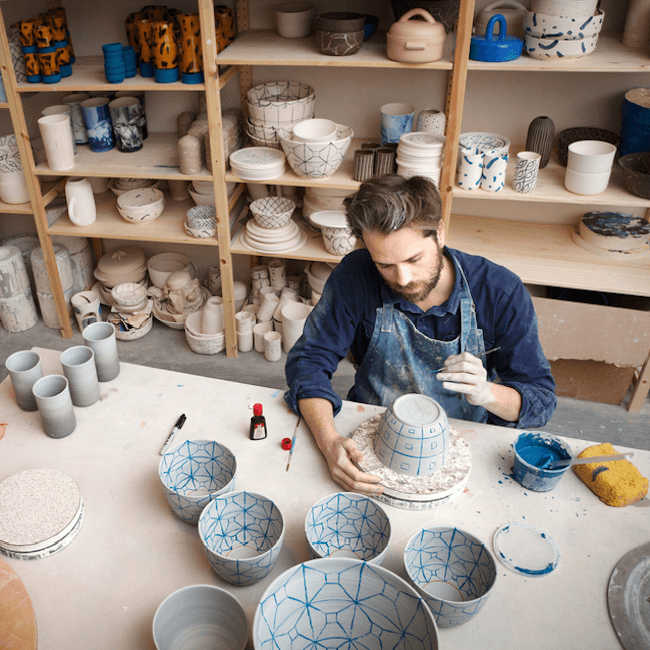With all the enthusiasm of someone explaining a passion to a newcomer, New York Times reporter Tim McKeough declared that studio ceramics are “white hot.” The feature ran in the Times’ Fashion and Style section last Wednesday. CFile Editor Garth Clark said skill sets for those featured in the article vary from capable to wishful but the attention is welcome. Clark responded to the article at length in another post.
McKeough begins by breathlessly listing all of the trendy boutiques and magazines that have been prominently featuring ceramics lately, then he links ceramics to that unimpeachable bellwether of hipness: young people.
Above image: Forrest Lewinger of Workaday Handmade in Queens works in the studio. Photograph by Deidre Schoo for the Times.
And among certain creative-minded millennials, ceramics have replaced jewelry and furniture made from salvaged lumber as the craft du jour, with access to choice kilns as a status symbol to be flaunted on Pinterest and Instagram.
“There is beauty in imperfection and having items that are really handmade,” said the fashion designer Steven Alan, who populates his boutiques with textural American and Japanese ceramics in neutral hues.
While terrariums, Edison bulb light fixtures and fixed-gear bicycles have all enjoyed moments of demarcating cool, handcrafted small-batch ceramics are suddenly the accessory of the moment.

Works by Primary Essentials in Brooklyn. Photograph by Deidre Schoo for the Times.
It has to be difficult to report trend stories quantitatively. But rather than telling us about all of the millennials on Instagram who are posting selfies with their kilns, McKeough found an interesting piece of data: in just one year the Rhode Island School of Design has seen a 50 percent jump in the number graduate students majoring in ceramics. He quotes associate professor Katy Schimert, who said that her department is seeing an influx of students from other design departments who want to give ceramics a try. It could be a fluke, but in conjunction with success stories like Heath Ceramics, the trend becomes more apparent.
Along the way, they transformed Heath from a niche company, which did about $1 million in sales in 2003, to a globally known outfit with 200 employees that sells about $20 million in products a year. This October, it received a National Design Award from the Cooper Hewitt, Smithsonian Design Museum.
But like a lot of emerging potters, the couple says one of the original reasons they were attracted to ceramics was that it allowed them to oversee the design process from start to finish.
“The nice thing about clay is that you can do it all, and it doesn’t take a lot of resources to build it up,” Mr. Petravic said. “You can’t buy a forge to make metal things. But clay and a wheel, or a mold, and a kiln, is pretty straightforward.”

A shelf at Still House in Manhattan. Photograph by Deidre Schoo for the Times.
The question of “why?” in trend stories mostly boils down to a guess, one that seems to fit in with the popular attitude about the times we’re living in. It’s more poetry than cold, hard facts. McKeough found a likely enough explanation: ceramics have more humanity than the digital objects we surround ourselves with today. Technology can be useful, it can be well-designed and attractive, but it’s all alike. Your cell phone is identical to millions of others. It has no story. No romance. Ceramics, on the other hand, resists uniformity and is steeped in individual narrative.
“People are looking to have their humanity reflected back at them,” said the veteran potter David Reid, a co-founder of KleinReid, a ceramics company in New York. “People are moving back from slick and stainless steel to something warmer.”
Bill Rodgers is the Managing Editor of cfile.daily.

Lewinger working at the wheel. Photograph by Deidre Schoo for the Times.

I don’t think I’ve ever been part of a “white hot trend”…I’m kinda excited.
Couldn’t agree more! I wrote an academic paper on the subject just a few weeks ago! You can check it out here! (http://bonedrybodies.weebly.com/blog/the-new-it-potters)